A History Of The Most Impractical Weapons Ever Used In War
A lot of brainpower goes into designing weapons of war. Unfortunately, in a complicated situation, brainpower is a terrible substitute for testing. Here are some of the ingenious weapons of war that were great on paper and terrible in practice.
I remember an engineer giving a talk at my college. He and a team had worked with the US military and built an "iron man" suit. It combined a "shell" of armor with multiple weapons, radios, and other tools needed on the battlefield. Soldiers could march through a combat area, doing whatever needed to be done, invulnerable and unstoppable. Finally, he and his team presented a rough prototype to veterans, asking them to give suggestions about practical modifications for the field. Nearly all the soldiers asked for an escape hatch. What looked to the engineer like an invulnerable walking tank looked to the soldiers like a slow, ungainly, hot, highly-visible death trap. Sometimes a great idea and practical reality just don't line up. We can see that a lot throughout history.
The Poorly-Designed Weapons
Ever heard of the Vandenburgh volley gun? It was a weapon so ineffective that, despite being designed by the northern General Origen Vandenburgh, it was sold to the Confederacy during the Civil War and no one really minded. Volley guns - guns with multiple barrels that can be fired simultaneously - have been rattling around people's heads since da Vinci's time. The trade-off is always the same. The firer can either aim or spray. If aim is important, all the barrels are pretty much parallel. If spray is important, the barrels spread out in all directions. A version of the volley gun, called a duck's foot pistol because of the way the barrels splayed out from the handle, was at the time popular among bank guards and other people who feared getting mobbed. The Vandenburgh gun was intended to let one person take on many, which was perfect for the outnumbered south. But it's near-parallel barrels let a soldier take out whoever was in front of him, but did nothing to stop anyone who was a bit to the side. Essentially, it required the shooter to use multiple bullets for every single person they killed.
The triebflügel was a very practical solution to a very specific problem. Allied bombers were doing a lot of damage in Germany at the end of World War II. In particular, they were doing damage to airfields, limiting Germany's ability to get their planes in the air. The triebflügel had three blades powered by rockets. It could take off vertically, and, once in the air, fly incredibly fast. Too fast and well-armored to be threatened by anything else in the sky, it would go after Allied planes and turn the tide of the war. Pilots loved it, until they wondered how they were going to land it. The triebflügel would have to back its way into the ground like a giant, rocket powered station wagon backing its way into a compact parking spot. Even if the pilot could turn around and face the rear of the plane, his view would be blocked by the spinning blades.
At least that weapon stopped at the design stage. During World War I, the newly-emerging Air Force got cocky about their abilities to design flying machines and developed an armored car. The "wind waggon" was meant to cross terrain like sand that other cars had trouble with. It had a propeller and a plane-like engine. It did not have room or power for a lot of guns, but it had a machine gun mounted on the front, so that was okay, right? Wrong. Planes did not stay in the air because they were sturdy. They stayed in the air because they were hard to shoot, particularly from the ground. The wind waggon was easy to shoot, and was undefended as long as the enemy wasn't directly in front of it. As soon as it got hit by a few bullets, it slowed to a stop.
The Sticky Bomb was a famous, or perhaps infamous, weapon of World War II. It was most popular with the Home Army, which was the British unit of soldiers, generally too old to fight on the front lines, readied to defend Britain against invasion. It was a maraca-looking grenade that had two pins and a trigger. The first pin would release the outer metal shell of the bomb, exposing a layer of adhesive. The second pin would activate the firing mechanism. There was then the trigger on the handle which had to be released in order for the bomb to go off - usually after five seconds. Leaving aside the fact that the adhesive stuck just as easily to a uniform as to anything else, the grenade worked best when placed on a certain part of a tank. That meant walking up to a tank and sticking a bomb to it. While the person placing the grenade was there, they might as well do a little washing, because the adhesive wouldn't stick to a dirty tank.
Then there was the Mark 14 torpedo, which was so bad that it started the "Great Torpedo Scandal." That scandal was shocking in part because the torpedo's designers and testers refused to acknowledge that their torpedo had any problems at all. It's hard to see how they managed to do it. Seven out of every ten Mark 14 torpedoes fired failed in some way. Some were duds. Some missed because they had a bad depth sensor. The exploding mechanism of the Mark 14 was tested in the North Atlantic and used in the South Pacific, where magnetic influences were different, and so many torpedoes simply failed to explode. Some did explode. One went in a circle and sank its own submarine. Those few that were effective were generally fixed in the field by actual submariners who knew what they were doing.
The Chaotic Weapons
The most feared and reviled weapons, flame-throwers, gas, and animal-guided weapons, have generally fallen out of use. Some of them have been made illegal. Their illegality is correct from a moral perspective, but may not have much to do with why the weapons aren't as common today as they once were.
Gas, for example, is often a terribly impractical weapon. Gas goes wherever the wind goes, so if the wind changes, gas can get thrown right back in the face of whoever launched it. Gas attacks required a flexibility that was not conducive to long-term plans or large-scale warfare. InGoodbye to All That, a memoir of his time in World War I, Robert Graves remembers a long-planned attack that was meant to start with gas which would blow over the German lines and create chaos, allowing British soldiers to attack. When the day came for the attack, there was no wind. When told about the lack of wind, those in charge of the attack insisted every be done as planned. The British launched tear gas, which stayed directly over them and over the no man's land between the trenches. They then marched into their own gas to face the unaffected German soldiers.
Even if used successfully, poison gas lingers in an area, so if an army is to capture ground cleared by gas, they have to march directly into the poison. Mustard gas, when released, often never left the area. It settled to the ground in a sludge which could stay put for months, contaminating and burning anything that came in contact with it.
Flamethrowers could be very effective weapons, but they were lethal to the people who used them as well as the people who faced them. When first used, they required two-man teams. These teams had an extremely short life expectancy. Operating a flamethrower means carrying a massive amount of volatile chemicals near fire. Accident alone could take out a flamethrower operator. It also requires standing up in the middle of a war zone with a giant line of fire that points straight to the soldier's location. Although the US military didn't stop using flamethrowers until 1978, when they did, they did so because the flamethrower was considered no longer a practical weapon of war.
Much has been written about various militaries using animals in war. Most of it isn't complimentary, nor should it be. Animals were just one more chaotic element in an already-chaotic situation, and they almost never reacted the way they were supposed to. When Russia trained dogs to run under tanks, with the idea that they would carry bombs under enemy tanks, the dogs, trained on non-rolling tanks without constant gunfire, refused to go under moving tanks. Those few who lingered near tanks were usually shot.
When the United States put bomb vests on bats and dumped them out of an airplane over a model town in New Mexico, most simply fell to the ground and died. Some flew off and roosted under the eaves of Carlsbad Army Airfield Auxiliary Air Base, setting it aflame. While some animals can be trained to provide specific functions, they are usually defensive - identifying mines and other traps - rather than offensive.
The Simply Insane Weapons
And then there are the weapons that were just crazy. A relatively-benign example of these weapons was the Panjandrum, designed in World War II. It was a big metal wheel designed to spin using explosives. Propaganda images show it as fearsome, lined with fire and unstoppable, clearing everything in its path. In real life, it looked like a poorly-made firework.
This was a weapon so impractical and silly that some people believe it wasn't even meant to be a weapon. It was meant to make Germany think that the Allies were landing somewhere with wide beaches which would allow the panjandrum to work.
Things really got crazy when nuclear weapons entered the picture. Colin Powell has famously said about nukes, "The one thing that I convinced myself after all these years of exposure to the use of nuclear weapons is that they were useless." And those were conventional nuclear weapons. Terrifying things happened when nuclear weapons designers got creative and made specialty bombs.
The most infamous of these was probably the Davy Crockett. Designed to be used by a three-person crew, the Davy Crockett was a tiny nuclear bomb that could be carried around in the field. Over two thousand were made, along with launchers for them. Some sources say that the launchers didn't get the nukes far enough from the launching team to keep them from getting killed themselves, but the launcher seems to have a range of up to two and a half miles. The bigger problem was accuracy. There wasn't any way to make sure the nuke hit the target, so the bomb was more of a radiation dispenser than a surgical strike. Radiation from the bomb killed anything within a quarter mile of where the Davy Crockett came down.
Then there was the Blue Peacock. This nuclear bomb was meant to be buried all over Germany, in case Russia some day invaded. The Germans would retreat and set the timer for the ten kiloton bomb. Eventually, when the Russian army was on top of them, they would go off. And if the bombs didn't get the army, well, at least no one would want to march through Germany for a while. What's amazing about this is that the British actually produced one before the project was shut down. To put it in perspective, the item list for the project included chicken wire and chicken feed. Why? Because chickens would be buried with the bomb in order to keep the electronics warm enough to work during the winter, and the chicken wire would keep them from pecking at the wire. This was so insane that, when the papers about it were declassified on April 1, 2004, it was taken for an April Fool's Day joke.
Sticky Bomb Image: Imperial War Museum, Torpedo Image: US Navy, Flamethrower Image: German Federal Archives, Bat Fire Image: United States Army Air Forces, Davy Crockett Bomb: US Cold War.
[Sources: The Vandenburgh Volley Gun, Early Armored Cars, The Worst Military Weapons in the History of Modern War, History.net, Chemical Warfare Proved Ineffective, The Davy Crockett, Cold War Bomb Warmed By Chickens]
from
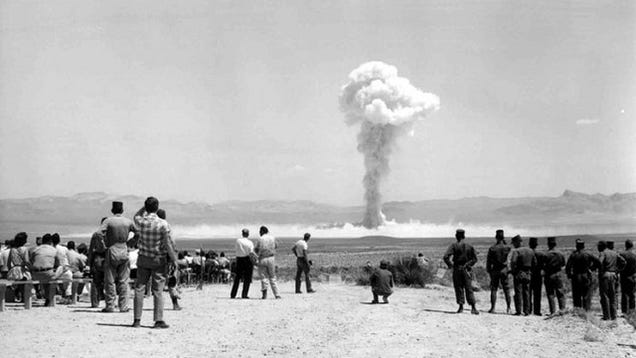
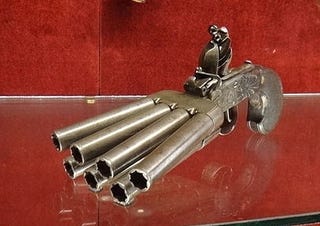
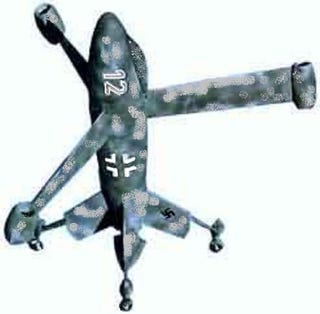
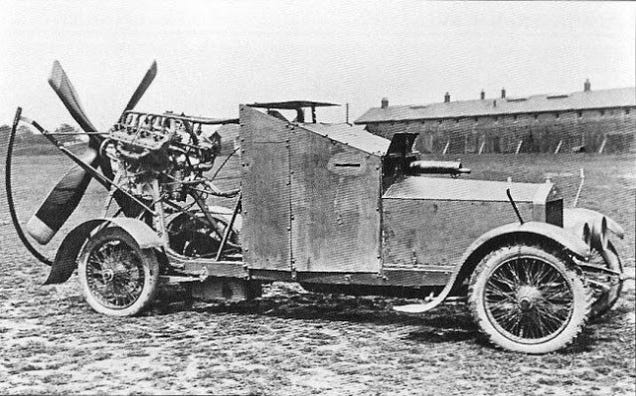
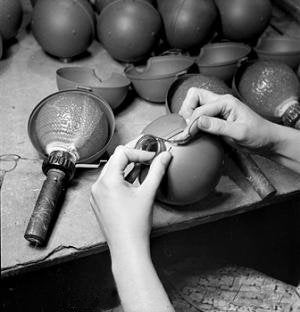

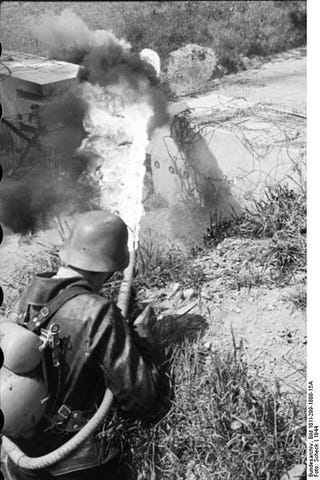
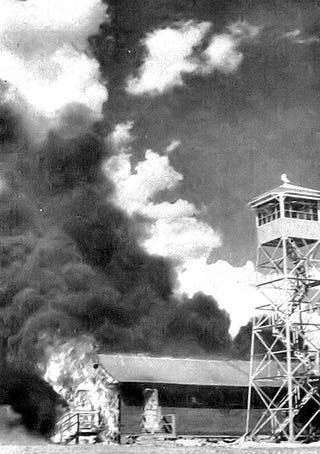
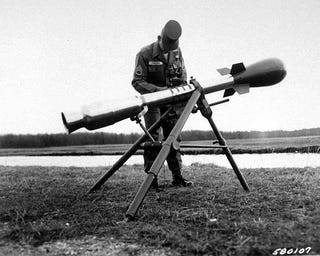
Wow...I doin't think I want to comment on that.
ReplyDelete